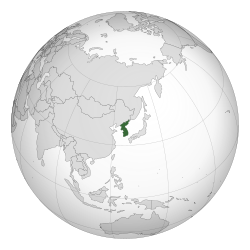Imperial Korea
| Korean Empire Greater Korean Empire |
||||||||||||
|
대한제국(大韓帝國) Daehan Jeguk |
||||||||||||
|
||||||||||||
|
||||||||||||
|
Motto 광명천지 (Hanja: 光明天地) (English: Let the land be enlightened ) |
||||||||||||
|
Anthem |
||||||||||||
|
Territory of the Korean Empire
|
||||||||||||
| Capital | Hanseong (Seoul) | |||||||||||
| Languages | Korean | |||||||||||
| Religion |
Neo-Confucianism Korean Buddhism Christianity |
|||||||||||
| Government | Absolute monarchy | |||||||||||
| Emperor | ||||||||||||
| • | 1897–1907 | Gojong (first) | ||||||||||
| • | 1907–1910 | Sunjong (last) | ||||||||||
| Prime Ministera | ||||||||||||
| • | 1895 | Park Yeong hyo | ||||||||||
| • | 1897–1898 | Yun Yong sun | ||||||||||
| • | 1905 | Han Kyu sul | ||||||||||
| • | 1905–1907 | Pak Che soon | ||||||||||
| • | 1907–1910 | Ye Wan yong | ||||||||||
| Legislature | Jungchuwon (중추원,中樞院) | |||||||||||
| Historical era | New Imperialism | |||||||||||
| • | Empire proclaimed | 13 October 1897 | ||||||||||
| • | Constitution | 17 August 1899 | ||||||||||
| • | Eulsa Treaty | 17 November 1905 | ||||||||||
| • | Hague Secret Emissary Affair | 1907 | ||||||||||
| • | Annexed by Japan | 29 August 1910 | ||||||||||
| Population | ||||||||||||
| • | 1900 est. | 17,082,000 | ||||||||||
| Currency |
Yang (1897–1902) Won (1902–10) |
|||||||||||
|
||||||||||||
| Today part of |
|
|||||||||||
| a총리대신 (總理大臣) later changed name to 의정대신 (議政大臣) in 1905, and renamed 총리대신 in 1907. | ||||||||||||
| Korean Empire | |
| Hangul | |
|---|---|
| Hanja | |
| Revised Romanization | Daehan Jeguk |
| IPA | [tɛ.ɦan.dʑe.ɡuk̚] |
The Korean Empire was proclaimed in October 1897, after the Donghak Peasant Revolution of 1894 to 1895 and Gabo Reforms that swept the country from 1894 to 1896. It lasted until the annexation of Korea by Japan in August 1910.
Emperor Gojong oversaw the partial modernization of the military, economy, land system, education system, and various industries. Japan became wary of Korea's modernization and industrialization attempt through Gwangmu Reforms, and after the assassination of the Resident-General Itō Hirobumi, decided to forcibly annex the Korean Empire.
Korea in the Joseon Dynasty had been a nominal client kingdom of China in the Qing Dynasty. Towards the end of the 19th century, influence over Korea was increasingly an area of conflict between the Qing and Japan. The First Sino-Japanese War marked the rapid decline of any power the Joseon state had managed to hold against foreign interference, as the battles of the conflict itself had been fought on Korean soil and the surrounding seas. With its newfound preeminence over the waning and weak Qing dynasty, Japan had delegates negotiate the Treaty of Shimonoseki with the Qing dynasty. Through signing the treaty, a move designed to prevent the southern expansion of Russia, Japan wrested control over the Liaodong Peninsula from Qing and more importantly over Korea. However, Russia recognized this agreement as an act against its interests in northeastern China and eventually brought France and Germany to its side, in saying that the Liaodong Peninsula should be repatriated to Qing China.
At the time, Japan was powerless to resist such foreign pressure, especially by nations that it considered far more advanced and which it sought to emulate, and as such relinquished its claim to Liaodong Peninsula. With the success of the three-country intervention (Russia, France, Germany), Russia emerged as another major power in East Asia, replacing the Qing Dynasty as the entity that the Joseon court's many government officials advocated close ties with to prevent more Japanese meddling in Korean politics. Queen Min (posthumously titled Empress Myeongseong), the consort of King Gojong, also recognized this change and formally established closer diplomatic relations with Russia to counter Japanese influence.
...
Wikipedia



